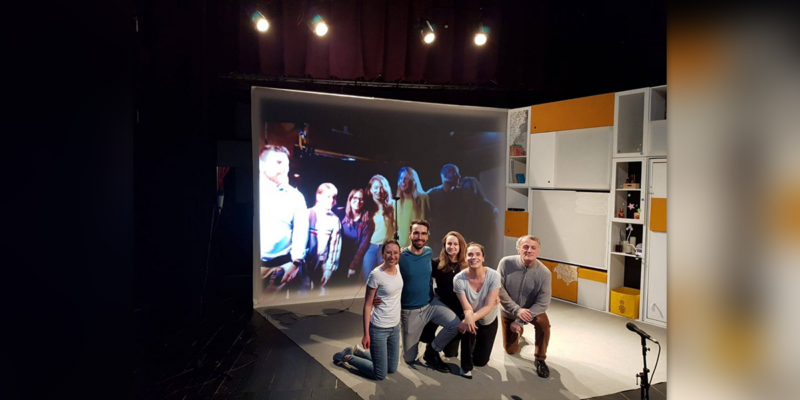Tony’s Rants: Tone Down the Tech!

The stack of publications was piling up on the corner of my desk. I thought it was about time to read them. There were so many articles about using tech in our schools; tech to collaborate, tech to teach, tech to produce content, on and on. I had to stop and ask myself, “What did I do?” I have three sons and they all watched their dad embrace technology, day after day and night after night, behind a glowing laptop screen in a trance-like state with a perpetual perm-a-grin. As I looked at all the photos of the articles I was reading, I saw the same perm-a-grin. The man has become the machine! Pressing buttons, turning knobs, data entry and compiling zeros and ones. The generation we enabled to use the technology for learning should consider using tech in moderation. Do not forget the human factor; find the balance. The following is a short comparison of some related articles. After you have a chance to read their summaries, I’d love to read your opinions regarding the use of technology.
Telepresence Robot Puts Remote Students In the Classroom – Author Chrissy Winke shares about a Texas school district in which small rural schools were having problems ensuring access to classrooms. Whether illness, injury or some other special circumstance kept a student absent for long periods of time, the district was required by law to provide that student with an education. So, rather than the inconvenience and expense of a teacher commuting to a student’s home, the district explored the possibility of using desktops with webcams on controllable robots.
However, the robots proved to be too problematic so they opted for a more realistic version – the Kubi, a robotic stand that holds a tablet. How does it work? The Kubi stand turns from side to side or up and down to allow the remote student to look around the room. It’s sort of like a head, allowing the person FaceTiming in for a class to move in the same way they would if that student was actually present. All the student needs to participate is a computer and an Internet connection. Absentee problems solved!
What Schools Must Learn From LA’s iPad Debacle — When Los Angeles schools began handing out iPads in the fall of 2013, it looked like one of the country’s most ambitious rollouts of technology in the classroom. The city’s school district planned to spend $1.3 billion putting iPads, preloaded with the Pearson curriculum, in the hands of every student in every school. Less than two years later, the whole deal was falling apart for a variety of potential reasons including preferential treatment, shoddy platforms and incomplete curriculum. So, the big question now being asked is: If one of the country’s largest school districts, one of the world’s largest tech companies, and one of the most established brands in education can’t make it work, can anyone?
According to Michael Horn, the author of “Blended: Using Disruptive Innovation to Improve Schools,” Los Angeles is a classic case of a school district getting caught up in the ed tech frenzy without fully thinking through why technology is important in the first place.
If you are considering implementing technology is your classrooms, the article’s author recommends you ask four key questions before moving forward:
- What will students learn?
- How will students learn?
- What resources will be needed?
- How will it work?
These are great questions for all industries, actually.
Why Taking it Slow With Technology Integration Leads to Success in the Classroom — Really, the entire brief article was fantastic so I am quoting it directly. But I included the link to the original source for your further investigation.
Every year numerous K-12 schools launch pilot programs to implement technology in their classrooms to help enhance student learning and improve academic success.
While many pilot programs have proven to be successful in schools throughout the country, there have been plenty of failures, too. About a year ago we learned the reasons behind L.A. Unified School District’s (LAUDS) failed $1.3 billion iPad initiative: not enough training, poor network security and overall insufficient planning.
LAUDS is of course not the only school district to have its pilot program fail. Numerous schools have deployed thousands of devices into its classrooms without a plan and have set themselves up for failure.
After speaking with numerous schools about their technology initiatives, both successful and unsuccessful, there is one piece of advice I have heard over and over, and that is to start slow.
Implementing large quantities of devices into every classroom is often overwhelming for teachers, students and IT managers. Providing training to teachers takes time, and when there is a large amount of teachers in need of training, the longer and more difficult the training process becomes. When school districts start small with their technology implementation, such as choosing one school or a few grades to participate in a pilot program, teachers are more easily provided adequate training, thus improving their use of technology in the classroom.
In addition to training difficulties, school districts that choose to implement large amounts of technology into numerous classrooms in a small period of time often risk losing site of the goals of the technology program. Instead, network problems, inadequate training and other issues distract schools from using technology to help enhance student learning.
Furthermore, starting slow with technology integration helps schools learn from any problems that evolve in the initial phases of the implementation, paving the way for success for any future plans to integrate new technology in classrooms
Implementing too much technology too fast can lose schools thousands, if not millions of dollars. If you’re thinking about implementing technology in your school, consider starting small. Be sure to gauge the results of the initial implementation and see what adjustments need to be made for future implementations. Perhaps most importantly, teachers need to be prepared to use the technology to help students learn better, and need support to work through both instructional and technical issues throughout the implementation.
The bottom line is integrating thousands of devices will not improve your school, preparing your teachers and students to use the new technology to enhance teaching and learning will. The easiest way to do that is to start slow.
Tony’s main takeaways:
- Clearly define your personal and professional goals before you decide to move forward with a technology roll-out.
- Partner with an industry expert to make sure your goals are realistic and within the scope of technology available.
- Keep the comfort level and ability of your colleagues, employees, and end-users at the forefront of your mind and while you are making key decisions.
- Most importantly, remember that technology is meant to enhance the human experience, not replace it.
What are your major take-aways? How will you apply the lessons others have learned?
Rant over,
Tony, the AV guy





